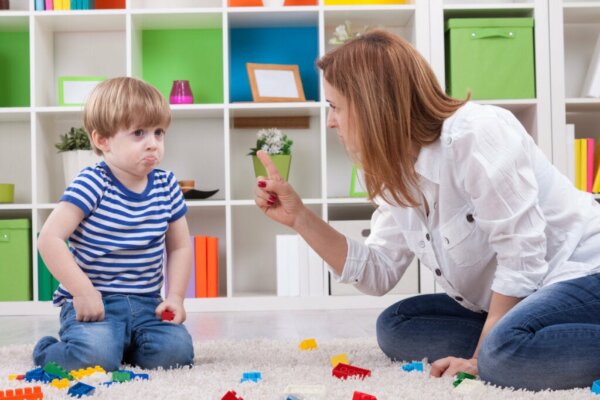Knowing how to deal with a disobedient child can be one of the most challenging aspects of being a parent. Furthermore, if action isn’t taken quickly and effectively, the relationship between parent and child can become extremely aversive.
Children display different types of disobedient behaviors. They range from ignoring commands, like refusing to sit down in a restaurant, to not following rules, like refusing to brush their teeth. To solve these problems, many parents tend to choose to either repeatedly issue the same commands, shout, or punish the child.
However, disobedient behaviors are part of the evolutionary development of a child. In fact, they’re characteristic of the early years and tend to disappear over time.
Achenbach and Edelbrock (1981) conducted a study and discovered that 50 percent of parents of children aged between five and six complained about disobedience. On the other hand, only 20 percent of the parents of 16-year-olds had similar problems.
How does a disobedient child behave?
Forehand and McMahon suggest that disobedience occurs when:
- Parents give the child a command, an instruction, or a request. However, the child doesn’t respond within a prescribed time. This is usually around 20 seconds.
- The parent asks the child to stop what they’re doing or not to start an undesired action. Nevertheless, the child doesn’t stop within the predetermined amount of time.
- The child doesn’t do something they’re meant to do. For example, brushing their teeth or getting dressed.
- The child engages in behavior that’s either implicitly or explicitly prohibited.
However, certain factors usually contribute to the maintenance of disobedient behavior, including:
- Coercive behaviors. For example, the child shouts to ask the parents something and the parent shouts at the child to try to get them to behave. Parents maintain these behaviors by both positive and negative reinforcement.
- The child’s obedience behaviors that are controlled by parental punishment are unstable.
- A progressive increase in intensity and frequency of coercive behaviors.
- The child learns by modeling the aggressive responses of their parents.
- The parents’ lack of ability increases intra- and extra-familial stress.
- A risk of the child developing more serious behaviors, like stealing.
What makes a child disobedient?
To explain behavioral disorders associated with obedience, we place the emphasis on instrumental learning factors, as well as family socialization processes.
Patterson has developed one of the most widely used models in the understanding of the development and maintenance of disobedience behaviors in children. In fact, he developed coercion theory.
Coercion theory
These are the main points:
- At birth, human beings have a range of rudimentary, instinctive, and coercive behaviors that are of adaptive importance. For example, crying.
- These behaviors quickly shape parental care behaviors towards the child. For instance, feeding.
- As the child develops, these rudimentary coercive behaviors change to more sophisticated ones. For example, social skills and verbal communication.
- If parents ignore verbal requests (sometimes due to parental socializing failures) and attend to rudimentary coercive control behavior, the former behavior is extinguished. However, the latter remains.
How to deal with a disobedient child
The treatment of disobedient behavior is based on operant conditioning. Parents learn how to apply these techniques in therapy sessions. Operant conditioning includes various processes. For example, time-out, response cost, extinction, etc. Positive reinforcement is an important aspect of the treatment. This is because:
- Out of all the operant conditioning techniques, reinforcement is the only one aimed at the construction of behavior. Other techniques are aimed at the reduction of behaviors.
- Parents often don’t properly use reinforcement techniques.
The goals of treatment
Treatment is based on a therapist’s work with the parents. Indeed, there’s minimal contact with the child. The goal is to change the contingencies determining the parent-child relationship to more appropriate ones. The parents then apply them with the child in their natural setting.
To this end, the therapist instructs parents in the principles of learning that underlie the techniques to be used. Instruction, modeling, role-play, and behavior rehearsal are used to help parents understand relevant skills and techniques. As a matter of fact, they usually practice them in a session before applying them with the child in their natural setting.
What are parents taught about disobedience?
One of the goals is to equip parents with parental skills. The procedure is as follows:
- The therapist explains the procedure and purpose of each skill.
- The therapist explains the skill through role-playing or video.
- The parent practices the skill of acting as a therapist with the child.
- The child becomes involved, and they’re told what the technique is all about. They practice it in the clinic. This practice seems to decrease the possibility of the child being resistant to it.
- The parents practice on their own with the child. Then, the therapist corrects them if necessary.
- The parents practice in the clinic with no intervention from the therapist.
- The therapist assigns tasks to the parents regarding the relevant skill. In addition, the therapist gives them written material and record sheets.

Differential attention
Parents need to learn to pay attention to the different kinds of behaviors. Because, on many occasions, parents tend to reinforce inappropriate behaviors. They do this by paying attention to them. In fact, they think that, by doing this, they’re actually reducing the behavior.
However, parents should pay attention to the behavior they want to be repeated and ignore the behavior they want to reduce. This will break the vicious cycle and the coercion between parents and child. Parents can learn how to do this by:
- Learning to attend to the correct behaviors with physical and verbal awards.
- Learning to extinguish inappropriate behaviors.
- Practicing at home daily for at least five minutes in free play situations. The goal is to later expand the behaviors of the child.
Commands and obedience for a disobedient child
One goal of the parent treatment programs for disobedience in children is to learn how to give commands. They should always be:
- Clear and specific.
- Comprehensible to children.
- As short as possible.
- Not contradictory to any other commands.
- Given one at a time and sufficiently spaced out.
- Not accompanied by physical contact. This is because physical contact tends to enforce non-compliance.
Knowing how to give commands is extremely important. This is the usual procedure:
- Give the command to the child.
- Allow a reasonable time for them to comply, usually around 20 seconds.
- If the child complies within the desired time, reinforce them.
- If the child doesn’t obey, the parent warns them that, if they don’t comply, there’ll be a negative consequence. For example, a time-out or response cost.
- If the child finally obeys, the parent reinforces them. If not, they administer the negative consequence.
- Once the parents have applied the negative consequence, they revert to the original situation. In other words, the child doesn’t get away with ignoring the order in the first place.
Once parents know how to do this at home, they can start to use it in other contexts. The final goal is for them to learn how to establish fixed rules that the child follows without the need to be continually reminded.
Disobedient Children: 5 Strategies
The post How to Deal with a Disobedient Child appeared first on Exploring your mind.













Comments